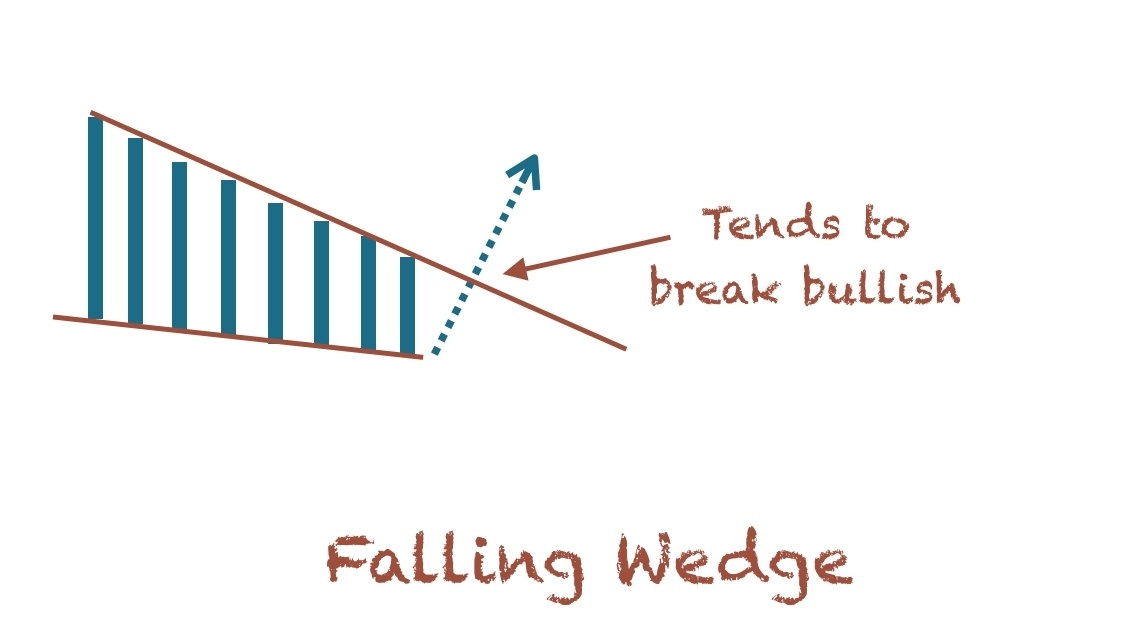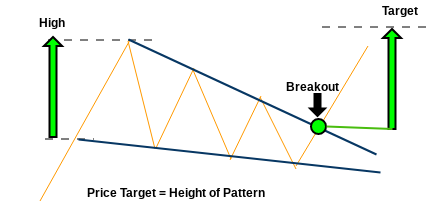
Falling and rising wedge patterns summed up Not quite ready to trade with real capital? Open an IG demo to trial your wedge strategy with £10,000 in virtual funds. Identify wedges using our comprehensive charting tools.Sign up for a live account to buy and sell thousands of indices, shares, currency pairs and more.Learn the principles of technical trading at IG Academy.Note how the index found support at 1600 on its upward move, which became an area of resistance in its subsequent downward breakout – and how the initial breakout roughly matches the range of the wedge. Trading consolidated between two lines that edged ever closer to each other, but shortly before the lines met the index broke below support and began a bear run. In early 2018, the Russell 2000 index entered into a wedge that precipitated the end of a long bull market. A spike in volume after it breaks out is a good sign that a bigger move is on the cards.

This will enable you to ensure that the move is confirmed before opening your position.Īnother common signal of a wedge that’s close to breakout is falling volume as the market consolidates. As a result, you can wait for a breakout to begin, then wait for it to return and bounce off the previous support area in the ascending wedge. Alternatively, you can use the general rule that support turns into resistance in a breakout, meaning the market may bounce off previous support levels on its way down. Essentially, here you are hoping for a significant move beyond the support trendline for a rising wedge, or resistance for a falling one.įor ascending wedges, for example, traders will often watch out for a move beyond a previous support point. One way to confirm the move is to wait for the breakout to start. Not all wedges will end in a breakout – so you’ll want to confirm the move before opening your position. Rising wedge vs falling wedge: what’s the difference? You can try out the IG trading platform with a demo account. To spot them, though, you’ll need a platform with powerful charting tools: such as the IG trading platform or MetaTrader 4. Studies have shown that falling wedges lead to breakouts slightly more often than rising ones. This is a sign that bullish opinion is either forming or reforming. But in this case, it’s important to note that the downward moves are getting shorter and shorter. When a market is falling, they’re a sign that traders are reconsidering the bear moveĪs with their counterpart, the rising wedge, it may seem counterintuitive to take a falling market as a sign of a coming bull move.When a market is on an uptrend, they represent a short-term pause before the long-term move takes hold once more.So it also often leads to breakouts – but while ascending wedges lead to bearish moves, downward ones lead to bullish moves. To form a descending wedge, the support and resistance lines have to both point in a downwards direction and the resistance line has to be steeper than the line of support.Ī falling wedge is essentially the exact opposite of a rising wedge. The falling wedge chart pattern is a recognisable price move that is formed when a market consolidates between two converging support and resistance lines. Open an IG account to start trading them now.

Rising wedges can occur on any market that’s popular with technical traders, including indices, forex and stocks. This causes a tide of selling that leads to significant downward momentum. Those waiting to short the market, meanwhile, will jump in. This negative sentiment builds up, so that when the market moves beyond its rising support line, anyone with a long position might rush to close their trade and limit their losses. This is the sign that bearish opinion is forming (or reforming, in the case of a continuation). But the key point to note is that the upward moves are getting shorter each time.


After all, each successive peak and trough is higher than the last. When a market is falling, they’re a short-term pause before the bear market takes hold once moreĪt first glance, an ascending wedge looks like a bullish move.When a market is in an uptrend, they’re a sign that traders are reconsidering the bull move.In the case of rising wedges, this breakout is usually bearish.Īscending wedges can occur when a market is rising or falling: Like head and shoulders, triangles and flags, wedges often lead to breakouts.


 0 kommentar(er)
0 kommentar(er)
